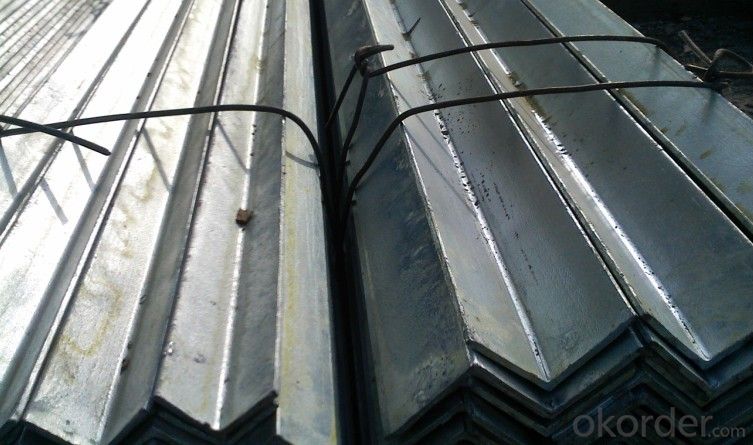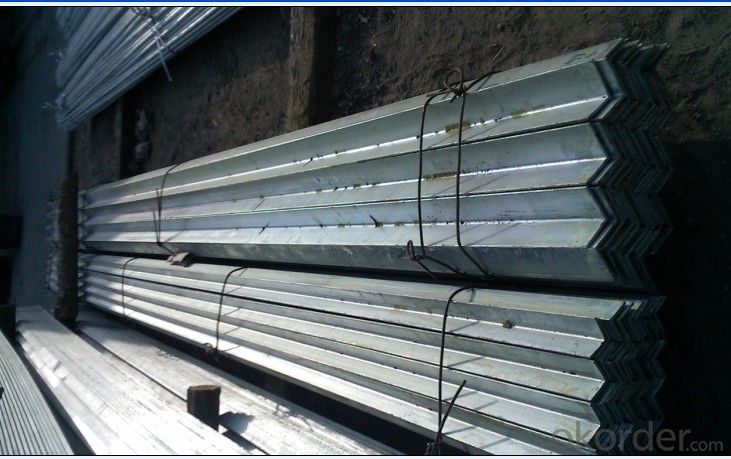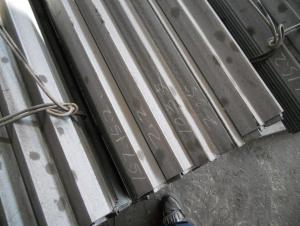Hot Rolled Carbon Steel Equal Angle with Many Sizes
- Loading Port:
- Tianjin
- Payment Terms:
- TT OR LC
- Min Order Qty:
- 20 m.t.
- Supply Capability:
- 1000 m.t./month
OKorder Service Pledge
OKorder Financial Service
You Might Also Like
Product Description:
OKorder is offering Hot Rolled Carbon Steel Equal Angle at great prices with worldwide shipping. Our supplier is a world-class manufacturer of steel, with our products utilized the world over. OKorder annually supplies products to European, North American and Asian markets. We provide quotations within 24 hours of receiving an inquiry and guarantee competitive prices.
Product Applications:
According to the needs of different structures, Angle can compose to different force support component, and also can be the connections between components. It is widely used in various building structures and engineering structures such as roof beams, bridges, transmission towers, hoisting machinery and transport machinery, ships, industrial furnaces, reaction tower, container frame and warehouse etc.
Product Advantages:
OKorder's Equal Angle are durable, strong, and resist corrosion.
Main Product Features:
· Premium quality
· Prompt delivery & seaworthy packing (30 days after receiving deposit)
· Corrosion resistance
· Can be recycled and reused
· Mill test certification
· Professional Service
· Competitive pricing
Product Specifications:
1. Invoicing on theoretical weight or actual weight as customer request
2. Length: 6m, 9m, 12m as following table
3. Sizes

Sizes: 25mm-250mm | ||
a*t | ||
25*2.5-4.0 | 70*6.0-9.0 | 130*9.0-15 |
30*2.5-6.6 | 75*6.0-9.0 | 140*10-14 |
36*3.0-5.0 | 80*5.0-10 | 150*10-20 |
38*2.3-6.0 | 90*7.0-10 | 160*10-16 |
40*3.0-5.0 | 100*6.0-12 | 175*12-15 |
45*4.0-6.0 | 110*8.0-10 | 180*12-18 |
50*4.0-6.0 | 120*6.0-15 | 200*14-25 |
60*4.0-8.0 | 125*8.0-14 | 250*25 |
4. Payment terms:
1).100% irrevocable L/C at sight.
2).30% T/T prepaid and the balance against the copy of B/L.
3).30% T/T prepaid and the balance against L/C
FAQ:
Q1: Why buy Materials & Equipment from OKorder.com?
A1: All products offered byOKorder.com are carefully selected from China's most reliable manufacturing enterprises. Through its ISO certifications, OKorder.com adheres to the highest standards and a commitment to supply chain safety and customer satisfaction.
Q2: How do we guarantee the quality of our products?
A2: We have established an advanced quality management system which conducts strict quality tests at every step, from raw materials to the final product. At the same time, we provide extensive follow-up service assurances as required.
Q3: How soon can we receive the product after purchase?
A3: Within three days of placing an order, we will begin production. The specific shipping date is dependent upon international and government factors, but is typically 7 to 10 workdays.


- Q:What are the design considerations when using steel angles?
- When using steel angles in design, there are several important considerations to keep in mind. First and foremost, the load-bearing capacity of the steel angles must be carefully evaluated. The size, thickness, and configuration of the angles should be chosen based on the anticipated loads and stresses that the structure will experience. Another consideration is the structural integrity of the connections between the steel angles and other elements of the design. The connections should be designed to ensure adequate strength and stiffness, as well as to accommodate any potential movement or deformation of the angles. It is also important to consider the potential for corrosion when using steel angles. Appropriate protective coatings or treatments should be applied to prevent rust and deterioration over time, particularly in outdoor or high-moisture environments. Aesthetics and visual appeal are also important design considerations. The shape, finish, and overall appearance of the steel angles should be chosen to align with the desired aesthetic of the project, whether it is a modern, industrial look or a more traditional and ornamental design. Finally, cost and availability should be taken into account when using steel angles. The cost of the materials, fabrication, and installation should be weighed against the overall budget for the project, and the availability of the desired sizes and configurations of steel angles should be considered to ensure a smooth and timely construction process. By carefully considering these design considerations, designers can effectively incorporate steel angles into their projects, ensuring structural integrity, aesthetic appeal, and cost-effectiveness.
- Q:What are the different connection methods for steel angles?
- Some of the different connection methods for steel angles include welding, bolting, and using mechanical fasteners such as screws or rivets. These methods are used to join steel angles together or to connect them to other structural elements. The choice of connection method depends on factors such as the load requirements, the design specifications, and the ease of installation.
- Q:What are the common applications of steel angles in architecture?
- Steel angles are widely used in architecture for various applications due to their versatility and strength. Some common applications of steel angles in architecture include: 1. Structural support: Steel angles are often used as structural support elements in building construction. They can be welded or bolted together to form a sturdy framework that provides strength and stability to the structure. 2. Framing: Steel angles are commonly used in framing applications such as door and window frames, as well as in the construction of roof trusses. They provide rigidity and support to the overall structure, ensuring that it remains stable and durable. 3. Reinforcement: Steel angles are often used to reinforce concrete structures. They can be embedded into concrete walls, columns, and beams to enhance their load-bearing capacity and resistance to deformation. 4. Staircases and handrails: Steel angles are frequently used in the construction of staircases and handrails. They provide a strong and durable framework that ensures the safety and stability of these architectural elements. 5. Architectural detailing: Steel angles are also utilized for architectural detailing purposes. They can be used to create decorative elements such as cornices, brackets, and ornamental features that add aesthetic appeal to the building. 6. Industrial applications: Steel angles find application in industrial settings, such as factories and warehouses, where they are used to create sturdy platforms, mezzanines, and equipment supports. Overall, steel angles are a versatile and reliable material that offers numerous benefits for architectural applications. Their strength, durability, and flexibility make them an ideal choice for a wide range of architectural structures and features.
- Q:Are there any limitations or restrictions on the use of steel angles in certain applications?
- Yes, there are limitations and restrictions on the use of steel angles in certain applications. These restrictions mainly depend on the specific engineering requirements, load bearing capacity, and structural stability needed for the application. Additionally, factors such as the type of project, environmental conditions, and building codes and regulations may also impose limitations on the use of steel angles. It is important to consult with a structural engineer or an industry professional to ensure proper selection and usage of steel angles for specific applications.
- Q:Can steel angles be used for manufacturing staircases?
- Yes, steel angles can be used for manufacturing staircases. Steel angles are commonly used in construction and fabrication due to their strength, durability, and versatility. When used for staircases, steel angles can provide the necessary support and structural integrity required to ensure the safety and stability of the staircase. They can be used to create the framework, stringers, and risers of the stairs, providing a solid base for the steps. Steel angles can be easily welded, bolted, or otherwise connected to form a sturdy staircase. Additionally, they can be easily customized to fit specific design requirements and can be coated or painted to enhance their aesthetic appeal. Overall, steel angles are a popular choice for manufacturing staircases due to their strength, durability, and adaptability.
- Q:Can steel angles be used for support columns?
- Yes, steel angles can be used for support columns. Steel angles offer excellent structural support and can be used to provide stability and strength to support columns in various construction and engineering applications. The angled shape of the steel angles helps distribute the load and provide additional rigidity to the support columns.
- Q:How do steel angles contribute to the overall aesthetics of a structure?
- There are multiple ways in which steel angles can enhance the overall aesthetics of a structure. To start with, they can serve as decorative elements that generate captivating and visually pleasing designs. By integrating steel angles into the architectural design, unique and distinctive features can be added to the structure. For instance, patterns, shapes, or even sculptures can be fashioned from steel angles, thereby enhancing the building's aesthetic appeal. Moreover, steel angles can establish a sense of balance and symmetry within the structure. Architects can strategically position steel angles at specific locations to create visually pleasing and harmonious designs. These angles can effectively break up large, monotonous surfaces, introducing depth and dimension to the structure and making it more visually captivating. Additionally, steel angles contribute to the aesthetic appeal of a structure by providing a sleek and modern appearance. The clean lines and sharp edges of steel angles lend a contemporary and industrial look to the building, which is often sought after in modern architecture. Furthermore, the use of steel angles can convey a sense of strength and stability, visually appealing and reassuring to observers. Lastly, steel angles can be employed to enhance the overall structural integrity of the building. While aesthetics are important, ensuring the safety and stability of the structure is crucial. By strategically placing steel angles, additional support and reinforcement can be provided, guaranteeing that the building is not only visually appealing but also structurally sound. In conclusion, steel angles contribute to the overall aesthetics of a structure by adding decorative elements, creating balance and symmetry, providing a sleek and modern appearance, and enhancing the structural integrity. By incorporating steel angles into the design, architects can create visually stunning buildings that are both aesthetically pleasing and structurally sound.
- Q:How do you calculate the shear strength of a steel angle?
- In order to determine the shear strength of a steel angle, one must take into account both the material properties and the angle's geometry. The shear strength represents the maximum load that the angle can bear before failing due to shear stress. Firstly, it is necessary to calculate the cross-sectional area of the steel angle. This can be achieved by multiplying the angle's thickness by the length of one of its sides. For instance, if the angle has a thickness of 0.25 inches and a side length of 4 inches, the cross-sectional area would amount to 1 square inch (0.25 inches x 4 inches). Subsequently, it is important to establish the shear stress that the angle can endure. Typically, this information is provided by the manufacturer and is indicated as a maximum value in pounds per square inch (psi) or megapascals (MPa). For example, let's assume the shear stress is specified as 30,000 psi. To calculate the shear strength, one must simply multiply the cross-sectional area by the shear stress. Utilizing the aforementioned values, the shear strength would equal 1 square inch x 30,000 psi = 30,000 pounds. It is worth noting that this computation assumes that the angle is subjected to a single shear plane and that the material is both uniform and isotropic. In practical applications, additional factors such as the presence of holes, welds, or other stress concentrations may need to be considered. In such cases, more complex calculations or testing may be necessary to accurately determine the shear strength.
- Q:How do you transport steel angles?
- Transporting steel angles requires careful planning and proper equipment to ensure their safe delivery. Here are some guidelines on how to transport steel angles effectively: 1. Choose the right mode of transportation: Depending on the quantity and distance, you can transport steel angles using various methods such as trucks, trailers, flatbeds, or shipping containers. Consider the dimensions and weight of the angles to determine the most suitable mode of transportation. 2. Secure the angles properly: Steel angles should be securely fastened to prevent any movement during transit. Use sturdy straps, chains, or ropes to hold them in place and protect them from shifting or falling. Avoid over-tightening, as it may cause damage to the angles. 3. Use protective measures: Steel angles are prone to rust and corrosion, especially when exposed to moisture. To prevent this, consider using protective coverings such as plastic wrap or tarps to shield them from rain, snow, or other environmental factors. You can also apply rust inhibitors or coatings to provide additional protection. 4. Distribute the weight evenly: Ensure that the weight of the steel angles is evenly distributed to prevent excessive strain on certain areas. Distribute the load evenly on the trailer or container to maintain balance and stability during transportation. 5. Proper loading and unloading: When loading and unloading steel angles, use appropriate lifting equipment such as cranes, forklifts, or hoists. Ensure that the equipment is capable of handling the weight and size of the angles. Follow proper lifting techniques and use specialized slings or clamps to avoid any damage during the process. 6. Obtain necessary permits and clearances: Depending on the size and weight of the steel angles and the transportation method used, you may need to obtain permits or clearances from relevant authorities. Check local regulations and ensure compliance to avoid any legal issues. 7. Plan the route and consider road conditions: Before transporting steel angles, plan the route carefully to avoid narrow roads, low bridges, or other obstacles that may hinder the safe passage of the load. Consider road conditions, traffic congestion, and any necessary detours to ensure a smooth and secure transportation process. By following these guidelines, you can transport steel angles safely and efficiently, minimizing the risk of damage and ensuring their timely delivery to the desired destination.
- Q:Are steel angles susceptible to fatigue failure?
- Yes, steel angles are susceptible to fatigue failure.
1. Manufacturer Overview |
|
|---|---|
| Location | |
| Year Established | |
| Annual Output Value | |
| Main Markets | |
| Company Certifications | |
2. Manufacturer Certificates |
|
|---|---|
| a) Certification Name | |
| Range | |
| Reference | |
| Validity Period | |
3. Manufacturer Capability |
|
|---|---|
| a)Trade Capacity | |
| Nearest Port | |
| Export Percentage | |
| No.of Employees in Trade Department | |
| Language Spoken: | |
| b)Factory Information | |
| Factory Size: | |
| No. of Production Lines | |
| Contract Manufacturing | |
| Product Price Range | |
Send your message to us
Hot Rolled Carbon Steel Equal Angle with Many Sizes
- Loading Port:
- Tianjin
- Payment Terms:
- TT OR LC
- Min Order Qty:
- 20 m.t.
- Supply Capability:
- 1000 m.t./month
OKorder Service Pledge
OKorder Financial Service
Similar products
New products
Hot products
Hot Searches
Related keywords





























